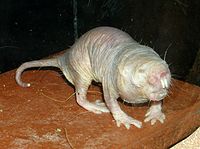
Photo from wikipedia
Rare pathological mutations in a small group of genes in humans can lead to pain insensitivity, and such cases have been instrumental in driving drug discovery programs for new analgesics.… Click to show full abstract
Rare pathological mutations in a small group of genes in humans can lead to pain insensitivity, and such cases have been instrumental in driving drug discovery programs for new analgesics. A less frequently trodden track is the examination of why some animals have evolved specific types of pain insensitivity. In this review, I will focus on insights that the biology of African molerats has given us in understanding the molecular basis of naturally occurring pain insensitivity. Many millions of years ago, evolution selected for changes inAfricanmole-rat genes producing specific types of pain insensitivity. It is striking that evolution selected for changes in genes and signal transduction pathways that were subsequently identified as being critical for human nociception, which is a major theme of this short review. It has long been known that naturally occurring chemical substances, called algogens, evoke painful sensations or avoidance in animals and humans. One of the best characterized algogens is capsaicin, a natural substance and the active ingredient of chili peppers, and the substance that confers theburnof hot peppers. There is a huge literature on capsaicin, characterizing its neurotoxic effects in neonatal animals, as well as its use as a substance to produce acute experimental pain in humans. Capsaicin causes burning sensations in humans and is thought to induce a similar sensation in most vertebrates, one major exception being all birds, which have evolved insensitivity to capsaicin likely because they are seed carriers for capsicum plants. It is not clear when capsaicin insensitivity evolved in the bird lineage, but it is possible that the ancestors of birds, ie, nonavian dinosaurs, were already insensitive to capsaicin. In 2008, we discovered that capsaicin was not a universal irritant inmammals because our studies on the nociceptive system of the nakedmole-rat (Heterocephalus glaber) revealed that this unusual subterranean mammal was completely insensitive to capsaicin. Further experiments also revealed that the nakedmole-rat displays no nerve growth factor (NGF)-induced thermal hyperalgesia, a phenomenon that is dependent on the presence of the capsaicinactivated ion channel TRPV1. Naked mole-rats have fascinated biologists for several decades because this underground-dwelling species native to East Africa has a unique biology. Naked mole-rats are 1 of only 2 eusocial mammals that live in very large colonies (up to 300 individuals) with a single breeding female who is the queen. In the late 1970s, Dr Jenny Jarvis from the University of Cape Town was the first to show that these animals could be kept and bred in the laboratory, and today naked mole-rat colonies are maintained in many laboratories worldwide. Naked mole-rats have so many extreme physiological features that wewould need an entire review to detail them all. Some of their most striking physiological adaptations include an extraordinarily long maximum life span of at least 36 years, apparent resistance to cancer, and resistance to extreme hypercapnia and hypoxia. In this review, I will examine the questions of how and why naked mole-rats, and more recently other African mole-rat species, lost certain types of pain sensitivity.
Journal Title: Pain
Year Published: 2020
Link to full text (if available)
Share on Social Media: Sign Up to like & get
recommendations!